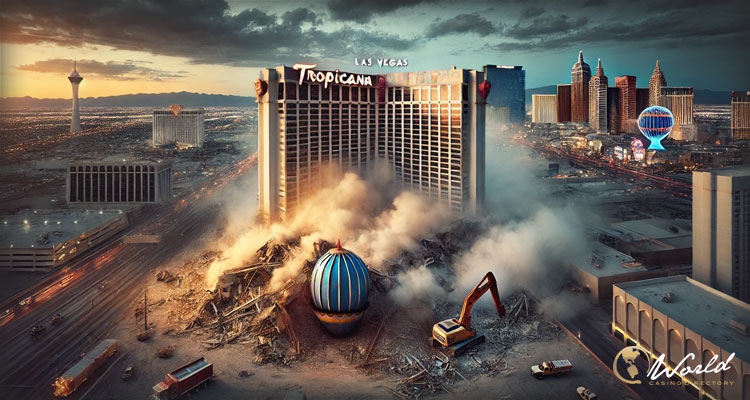The legendary Tropicana Las Vegas, once a beacon of glamour and luxury, has officially closed after 67 years of operation on the iconic Las Vegas Strip. This historic casino, intertwined with mob dealings and A-list celebrities, held its final ceremony in front of tearful employees and curious onlookers. The closure paves the way for the future—a $1.5 billion Major League Baseball stadium set to redefine the area as a hub of sports entertainment.
At its peak, Tropicana was a hotspot for the famed "Rat Pack" and served as a filming location for classic films like the 1971 James Bond movie "Diamonds Are Forever," where Sean Connery's Bond remarked, "I hear the Tropicana is very comfortable." However, the era of mob allure and Rat Pack cool has given way to a new Las Vegas—a Las Vegas where sports reign supreme.
Rich History
The Tropicana Casino opened in 1957, making it one of the oldest casinos on the Las Vegas Strip. At its opening, the population of Clark County had just surpassed 100,000, and the landscape of Las Vegas was largely desert. According to the Associated Press, the Tropicana was built at a cost of $15 million, featuring neatly trimmed lawns, towering tulip-shaped fountains, and striking mosaic tile interiors. It was dubbed "the Tiffany of the Las Vegas Strip," a nickname that highlighted its elegance and beauty.
Over the years, the casino attracted many entertainment heavyweights. Frank Sinatra, Elizabeth Taylor, and Sammy Davis Jr. frequented its halls, while music legends like Mel Tormé and Eddie Fisher performed there. The casino became a symbol of Las Vegas luxury and entertainment.
The last guest of the casino was Joe Zappulla from New Jersey, who spent $600 for a chance to stay at the iconic casino before its complete closure. Recalling his parents' visit to Tropicana in the 1960s, Zappulla was overwhelmed with nostalgia. "Old Las Vegas is disappearing," he said, tears streaming down his face. "I really have deep memories of that place."
Mob Connections and Star-Studded Gatherings
Despite its glamorous facade, Tropicana could not escape the influence of organized crime. Mob boss Frank Costello was closely involved with the casino's operations in its early days. Just weeks after Tropicana opened, Costello was shot in New York, leading investigators to uncover "skimmed" gambling profits and exposing the dark side of Las Vegas mob connections.
By the 1970s, federal authorities accused several individuals of conspiring to embezzle millions from Las Vegas casinos, including Tropicana. Although mob influence eventually waned, Tropicana continued to thrive, cementing its place in Las Vegas lore. The casino became the long-standing home of the Folies Bergere show, a topless cabaret that became a classic image of Las Vegas showgirls for nearly 50 years.
Years of Change
Like many of its contemporaries, Tropicana evolved with the times. In the 1980s, the casino was rebranded as "Island of Las Vegas" and introduced blackjack tables by the pool—a novelty that briefly captured the spirit of the era. In 2011, the casino underwent a South Beach-themed renovation, modernizing its services and competing with emerging mega-resorts.
However, despite changes, the original charm of Tropicana remained. Visitors like JT Seumala felt nostalgic walking under the iconic stained glass ceiling in the low-ceilinged lobby. "It feels like stepping back in time," Seumala recalled. But as time passed, the casino's influence diminished. Although Tropicana still attracted visitors, it paled in comparison to the large resorts now defining the Las Vegas Strip, including nearby giants like MGM Grand and Caesars Palace.
Bittersweet Farewell
For employees like bartender Charlie Granado, who worked at the casino for 38 years, the closure was a bittersweet moment. "It's time. The casino has reached its end," Granado said. "It makes me sad. But on the other hand, it's also a happy ending." On the last day of the casino's operation, employees gathered at the main entrance, some crying, others cheering, as they bid farewell to guests. The casino's doors were locked with chains, marking the end of an era.
Over 2,000 pounds of explosives were used on this iconic building. The Las Vegas Review-Journal released a video of the explosion, capturing the impressive moment as this historic building made way for a brighter future on the Las Vegas Strip.
The closure of Tropicana marks a significant turning point in the ongoing transformation of Las Vegas. The site is set to be demolished in October to make way for the $1.5 billion new stadium, which will host the Las Vegas Athletics, a Major League Baseball team relocating from Oakland. The planned stadium, set to open in 2028, will accommodate 33,000 fans, representing Las Vegas's continued shift towards a major sports franchise hub. The NFL's Las Vegas Raiders (who left Oakland in 2020) and the NHL's Las Vegas Golden Knights have already made their mark in the city. Now, with the arrival of Major League Baseball, Las Vegas will solidify its status as a premier sports destination.
The planned baseball stadium will occupy 9 acres, while Tropicana originally spanned 35 acres. Bally's Corp., which owns the remaining land, has announced plans to build a new resort on the remaining property.
As Las Vegas looks to the future, parts of Tropicana's history will be preserved. Casino artifacts have been sent to the Neon Museum and the University of Nevada, Las Vegas archives, with some items, such as the iconic Tiffany-style stained glass ceiling, being retained for possible integration into the new stadium.










